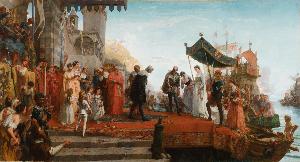Enrico Gamba
Enrico Gamba
สถานที่: Turin
เกิด: 1831
ความตาย: 1883
ชีวประวัติ:
Enrico Gamba was an Italian painter of genre scenes, period pieces, and a few portraits. Born in Turin in 1831, he died in the same city in 1883. Gamba's artistic career is characterized by his unique style, which blended elements of realism and romanticism.
Early Life and Training
Gamba's father worked for the Royal Accounting Office, and his brother Francesco was already an established painter when Enrico was a boy. At the age of twelve, he enrolled at the Accademia Albertina, where he studied with Michele Cusa, Giovanni Marghinotti, and Carlo Arienti. In 1850, he went to Germany, where he studied at the Städelschule in Frankfurt with Eduard von Steinle.
Artistic Career
Gamba's first major exhibitions were in 1854, at the "Promotrice di Torino", and 1855 at the "Esposizione di Brera", where he presented one of his best-known works, Titian's Funeral, which was bought by the Royal Family. He visited Leighton's studio in Paris and obtained a teaching position at the Accademia Albertina. Three of his best-known students were Luigi Capello, Giovanni Battista Quadrone, and Canuto Borelli. Some of Gamba's notable works include:
- The Arrival of Princess Beatriz of Portugal in Nice (1870)
- Titian's Funeral (1855)
- Giovanni Huss in carcere (1858), which can be found at the Galleria d'Arte Moderna in Milan
Gamba's style was influenced by his travels to Northern Europe and his friendship with the English painter Frederic Leighton. He also came under the influence of Friedrich Overbeck, a German painter.
Legacy
Enrico Gamba is considered one of the most important Italian painters of the 19th century. His works can be found in various museums, including the Galleria Sabauda in Turin. For more information about Enrico Gamba and his works, visit Wikioo.org or check out his page on Wikipedia. Key aspects of Enrico Gamba's artistic style include his attention to detail, use of color, and ability to capture the essence of his subjects. His paintings are a testament to his skill and artistry, and continue to be admired by art lovers today. Some of Gamba's works can also be found on Wikioo.org, where you can learn more about his life and artistic career. Gamba's paintings are a unique blend of realism and romanticism, making him one of the most interesting and important painters of his time.

